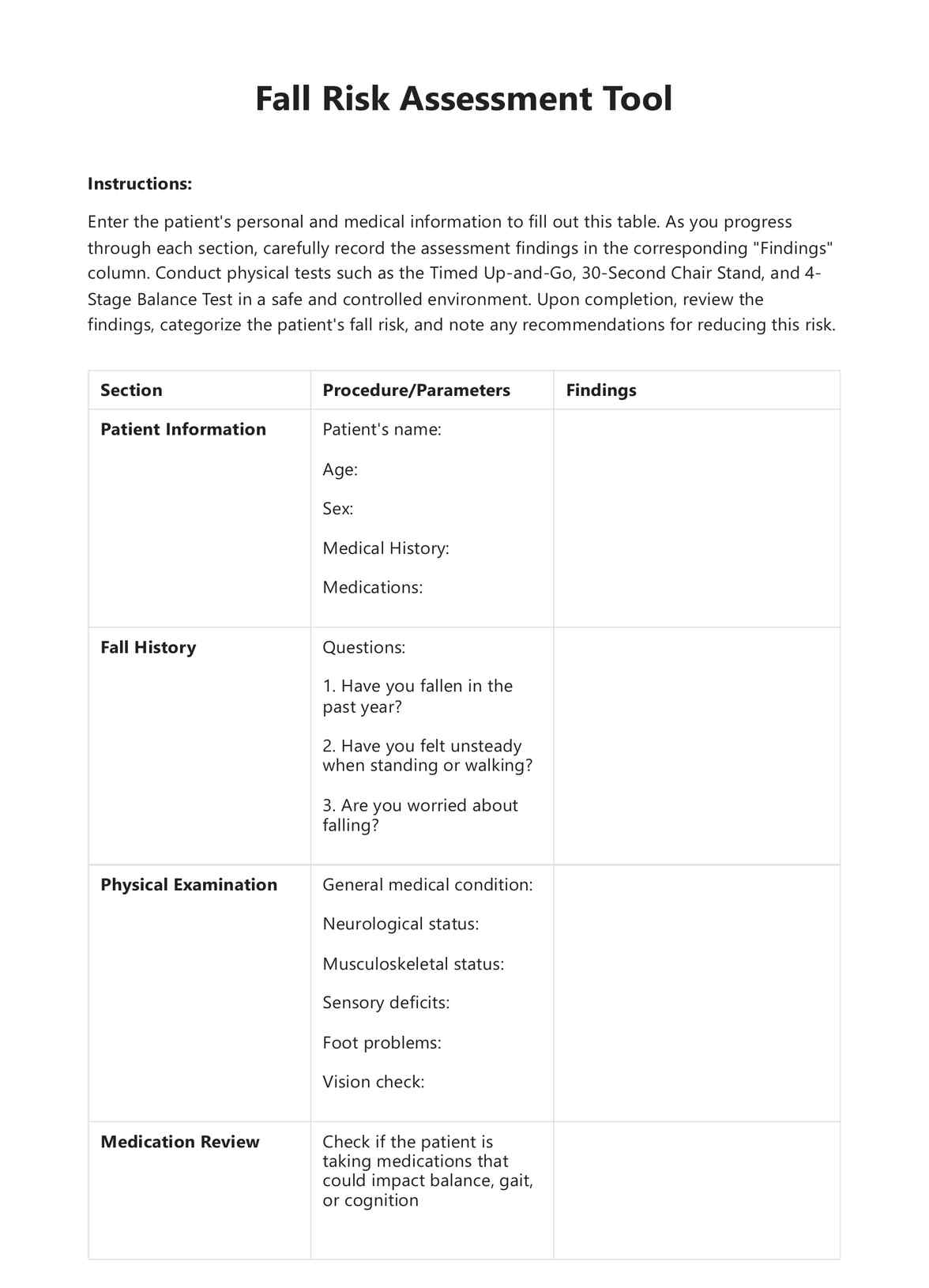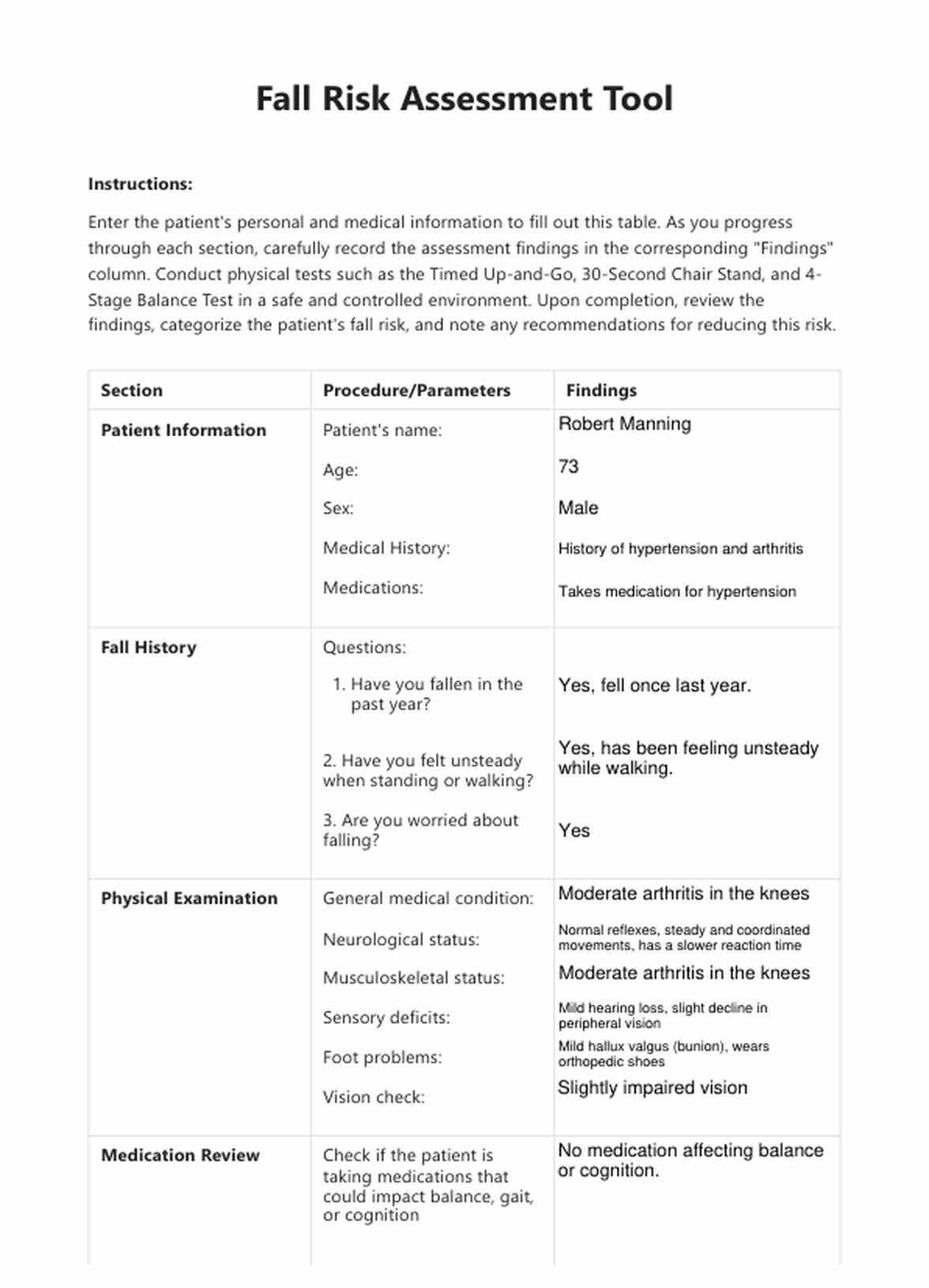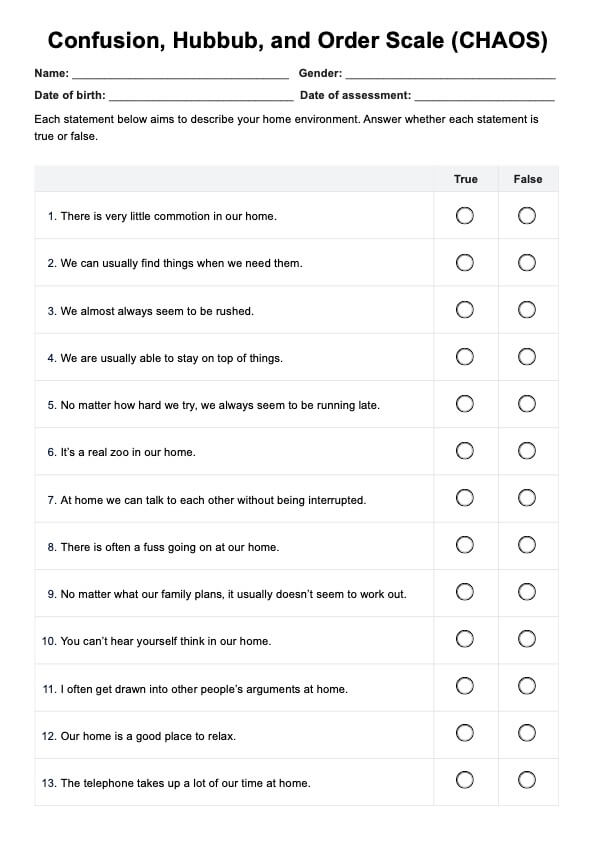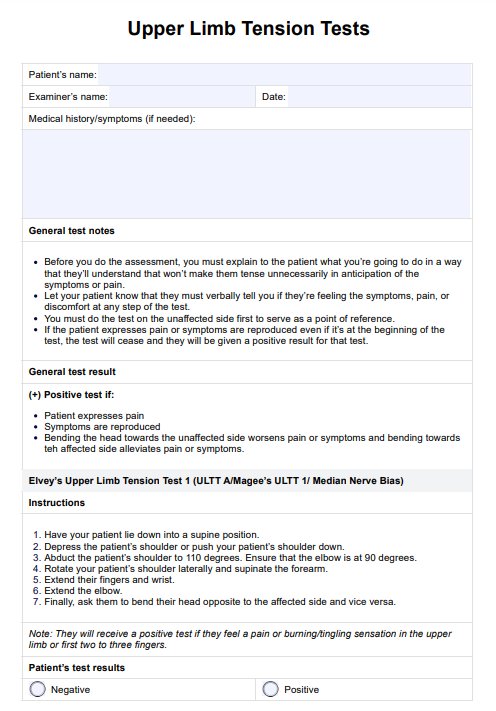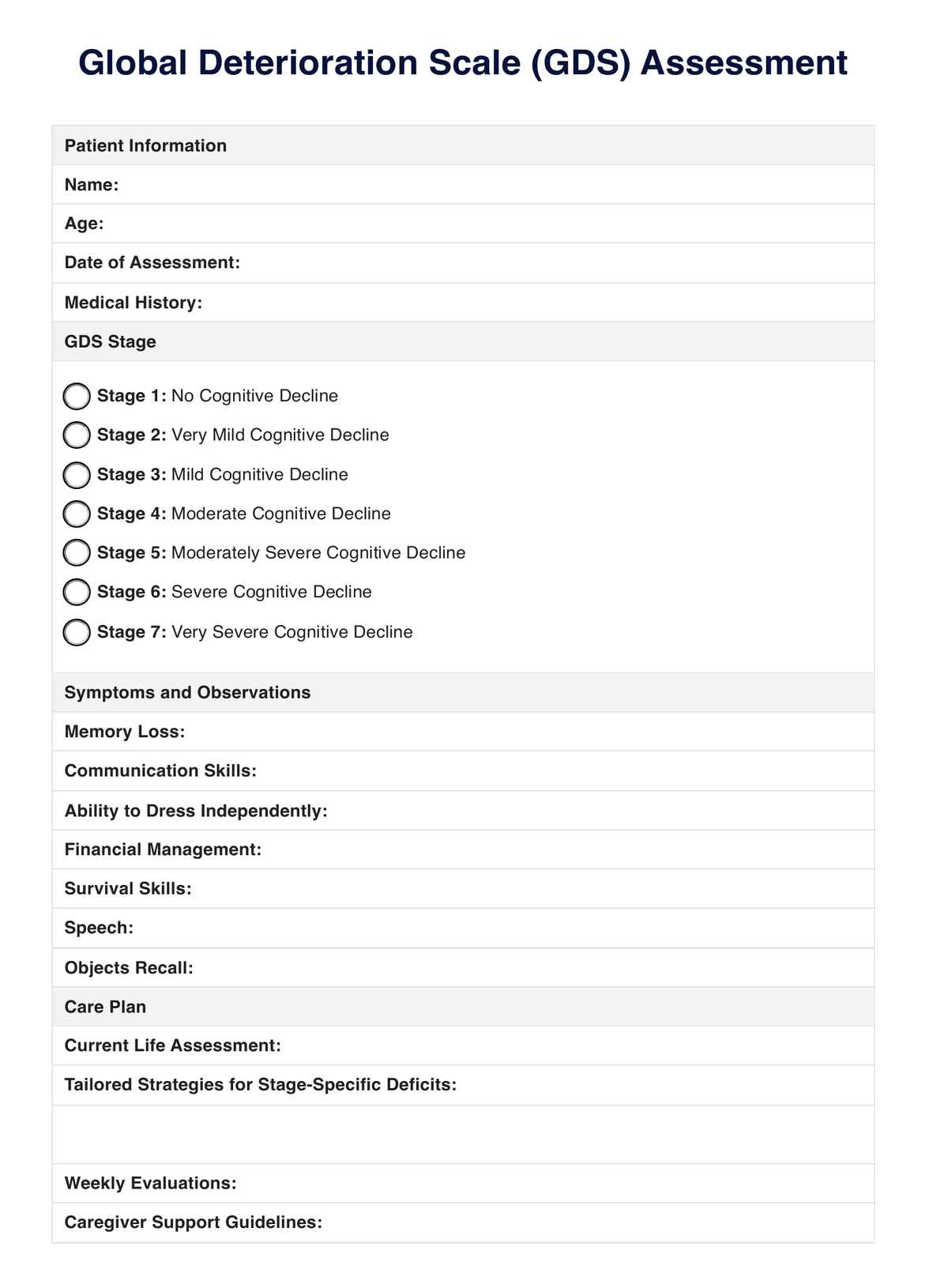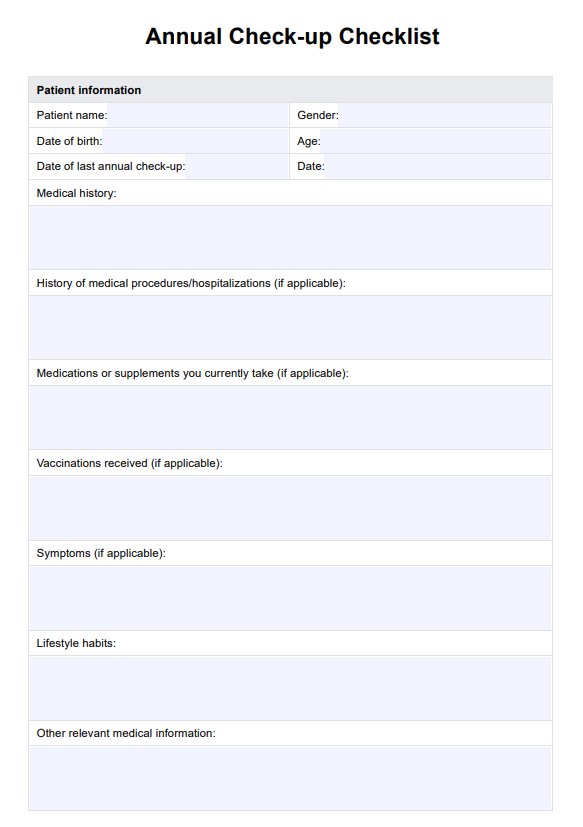Falls Risk Assessment
Uncover the essentials of Falls Risk Assessment. Learn what it is, how it works, and its benefits. Plus, get a free PDF download for practical application.


What is a Falls Risk Assessment?
A Falls Risk Assessment is a systematic approach designed to identify the potential risk of falls in individuals, particularly among older adults. This comprehensive assessment not only evaluates physical factors such as strength, balance, and gait but also considers the individual's overall health, medication usage, and environmental circumstances.
The process begins by gathering essential data regarding the individual's health history and any previous incidents of falls. An integral part of this assessment is understanding if there have been any problems with balance, standing, or walking, as these can significantly contribute to the risk of falling.
The healthcare provider then conducts a series of physical tests known as fall assessment tools, each designed to examine different aspects of the individual's physical capabilities. For instance, the Timed Up-and-Go (TUG) test checks gait, the 30-Second Chair Stand Test assesses strength and balance, and the 4-Stage Balance Test evaluates balance in varying degrees of difficulty.
In addition to these tests, the assessment includes reviewing the individual's medications, as certain drugs can affect balance and cognition, or cause dizziness and confusion, increasing the risk of falls. Lastly, the assessment may involve a review of the person's living environment, identifying any potential hazards that could lead to falls, such as poor lighting, loose rugs, or clutter on the floor.
The primary goal of a is to categorize individuals into low, moderate, or high risk of falling. This classification helps healthcare professionals devise personalized strategies and interventions to mitigate the risk of falls and related injuries, promoting safer and more confident mobility for the individual.
ABCs of Fall Risk
Sometimes, there is a common referral to the ABC's of fall risk. This pertains to those who are at a higher risk of falling and harming themselves, which includes the following:
- Ages over 85
- Bone disorders
- Coagulation disorders
- Surgery
Falls Risk Assessment Template
Falls Risk Assessment Example
How does this Falls Risk Assessment Tool work?
The Falls Risk Assessment Tool is a comprehensive approach to evaluating an individual's propensity for falls. It includes several steps:
Step 1: Gather Patient Information
This involves collecting data on the individual's age, sex, medical history, and current medications.
Step 2: Conduct a Fall History Review
When standing or walking, the individual is asked specific questions about their fall history and feelings of steadiness.
Step 3: Perform a Physical Examination
The individual's general medical condition, neurological status, musculoskeletal condition, sensory deficits, foot problems, and vision are evaluated.
Step 4: Review Medications
Medications that could impact balance, gait, or cognition are noted and considered in the assessment.
Step 5: Carry out a Gait & Balance Evaluation
Tests such as the Timed Up-and-Go (TUG) test, the 30-Second Chair Stand Test, and the 4-Stage Balance Test are performed to assess the individual's gait and balance.
Step 6: Conduct an Environmental Assessment
The individual's living environment is inspected for potential fall hazards.
Scoring
Once all the Falls Risk Assessment Tool steps have been completed, the information is compiled to provide a Falls Risk Score. This score categorizes the individual as having a low, moderate, or high risk of falling.
It also identifies key areas of concern, such as gait, strength, or balance, that must be addressed to mitigate fall risk.
When to use this Falls Assessment?
The Falls Risk Assessment Tool is a fundamental instrument that should be used periodically, particularly with older adults aged 65 and beyond. This demographic has a higher risk of falls due to age-associated factors like balance and mobility problems, chronic illnesses, and impaired vision.
This tool becomes even more crucial if an individual has a documented history of falls, unsteadiness while standing or walking, or is on medication that could impact balance, gait, or cognition.
However, not just these predisposed conditions warrant a Falls Risk Assessment. Any substantial changes in a person's health status - such as a new diagnosis, significant weight loss or gain, surgical procedures, or hospitalization - should prompt a reassessment of fall risk. Likewise, modifications in a person's medication regimen, particularly introducing drugs that may cause dizziness, drowsiness, or confusion, necessitate a review of fall risk.
This assessment tool can be applied in various settings, ensuring its broad applicability and usability. It can be used in homes where family members or caregivers can conduct preliminary evaluations.
Healthcare providers can use it during routine check-ups or dedicated visits in clinical or office settings. It's also highly useful in specialized care facilities like nursing homes or assisted living centers, where fall risk management is integral to personalized care plans.
Who are these Falls Risk Assessment PDFs for?
The Falls Risk Assessment tool is a comprehensive resource designed primarily for healthcare professionals engaged in direct patient care. Nurses, general practitioners, geriatric care providers, physiotherapists, and occupational therapists are among those who can employ this tool for routine evaluations, comprehensive check-ups, or targeted fall risk evaluations.
These professionals can use the tool to assess a patient's fall risk, identify contributing factors, and create tailored prevention strategies accordingly. It provides a structured approach to gathering patient data, assessing the physical condition and living environment, and organizing this information to lead to actionable insights and decisions.
However, the utility of this tool extends beyond healthcare professionals. It can be an informative and practical resource for caregivers or family members of older adults. While not a substitute for professional evaluation, the tool can guide non-medical individuals to understand the complex factors contributing to an increased risk of falls.
Understanding these risks can aid in making necessary lifestyle or environmental modifications and facilitate more informed conversations with healthcare providers. It helps ensure caregivers and families actively participate in fall prevention efforts, creating a safer environment for their loved ones.

Benefits of the Free Falls Risk Assessment
Implementing the Falls Risk Assessment in routine healthcare checks, particularly for adults 65 and older, can yield many benefits. From fostering patient safety to encouraging proactive care, this tool is a comprehensive solution to manage the risk of falls effectively.
1. Improved Patient Safety
By facilitating the identification of specific risk factors, the Falls Risk Assessment tool contributes significantly to patient safety. By flagging those individuals who may be more susceptible to falls, appropriate preventive measures can be implemented to avert potential falls and resultant injuries.
This proactive approach promotes a safer environment for the patient, thereby reducing the likelihood of injuries and their associated complications.
2. Comprehensive Evaluation
The Falls Risk Assessment tool thoroughly examines a patient's overall health status, making it an invaluable resource for comprehensive patient evaluation. It considers factors such as the patient's physical condition, current medication use, and even aspects of their home environment.
This wide-ranging review allows healthcare providers to understand a patient's potential risk factors, ultimately aiding in formulating an effective fall prevention strategy.
3. Easy to Use
The Falls Risk Assessment tool has been designed with user-friendliness at its core. Its straightforward design, clear instructions, and intuitive scoring system make it a breeze for healthcare professionals to incorporate into their practice. This ease of use ensures that the tool can be effectively utilized to maximize patient safety.
4. Promotes Proactive Care
The value of regular and repeated use of the Falls Risk Assessment tool lies in its capacity to highlight any changes in fall risk over time. It's not just a snapshot of a patient's current status but a tool for tracking their condition longitudinally. Regular assessments promote proactive care, facilitating early intervention when changes in risk factors are detected. This allows healthcare providers to stay ahead and mitigate potential risks before they lead to falls.
5. Facilitates Better Communication
Sharing the results of the Falls Risk Assessment with patients and their families opens the lines of communication about fall prevention strategies. It creates an opportunity for patients to understand better their own risk and for families to understand how they can help create a safer environment.
Better communication leads to a team approach to fall prevention, ensuring everyone understands the risks and the steps needed to mitigate them.
Commonly asked questions
The Falls Risk Assessment categorizes an individual's risk of falling into low, moderate, or high categories. It helps identify problem areas (gait, strength, balance) that must be addressed to reduce fall risk.
The assessment involves gathering patient information, reviewing fall history, conducting physical examinations, reviewing medications, evaluating gait and balance, and conducting an environmental assessment.
The assessment should be reviewed and updated regularly, especially if there's a significant change in the individual's health status or medication regimen. The CDC and American Geriatric Society recommend yearly assessments for all adults 65 and older.


